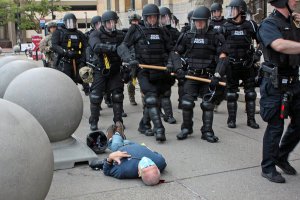Ronni
Well-known Member
- Location
- Nashville TN

Martin Gugino, a 75-year-old protester, lays on the ground after he was shoved by two police officers in Buffalo, New York.Jamie Quinn, via Reuters
An encounter in Buffalo last Thursday — in which two police officers shoved a 75-year-old man to the ground and left lying him there while blood poured out of his ear — was troubling partly because of the original police account.
The account claimed that the man “was injured when he tripped and fell.” If a video hadn’t existed, the truth might never have come out.
That’s a widespread problem:
- In Philadelphia last week, the police said that a man had pushed an officer off his bike; a video instead showed an officer striking the man with a baton.
- In a suburb of Sacramento in April, a police officer punched a 14-year-old boy multiple times while arresting him; the officer’s report didn’t mention the punches.
- The Minneapolis police’s account of George Floyd’s death initially left out the most important details, like the knee pressed on his neck for almost nine minutes.
Activists in the current protest movement have begun to focus on how they can turn the rallies of the past 10 days into lasting change, to reduce both racism and police brutality. And reducing the frequency of false reports by the police is likely to be a key issue.
Already, reform-minded prosecutors and police chiefs have taken some steps in the last few years. The top prosecutor in St. Louis, Kim Gardner, has stopped accepting new cases or search warrant requests from officers with a history of misconduct or lies. In Philadelphia and Seattle, prosecutors are creating similar “do not call” lists, The Marshall Project has reported.
Chris Magnus, the police chief in Tucson, Ariz., told the Marshall Project: “If I had my way, officers who lie wouldn’t just be put on a list, they’d be fired, and also not allowed to work in any other jurisdiction as a police officer ever again.” Often, though, police-union contracts prevent firing even officers with a record of brutality and dishonesty — which then casts a shadow over the many police officers who tell the truth.
(The Times published an investigation this weekend, explaining how police unions have amassed political power and blocked change.)
False police reports are not a new problem. What’s new are the videos that have caused people to realize how common they are. “When I was a reporter, it was the police officer’s word against the victim’s or suspect’s,” Jamie Stockwell, a deputy national editor at The Times, told me. “Cellphone video has changed the debate over policing.”

